Batch scanning using MP Navigator EX on an MX340 (Windows)
| Article ID: ART106369 | | | Date published: 05/11/2015 | | | Date last updated: 08/15/2015 |
Description
To perform batch scanning using MP Navigator EX, perform these steps.
Solution
Scanning Multiple Documents at One Time from the ADF (Auto Document Feeder)
Place multiple documents on the ADF (Auto Document Feeder) and scan at one time.
This section explains how to scan one side of the documents at a time. See "Scanning Sides of Documents at One Time" to scan sides of the documents automatically.
-
Place the documents on the ADF (Auto Document Feeder).
- Open the Document Tray.
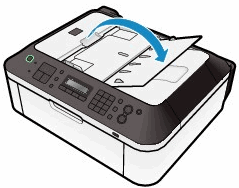
- Place the documents on the ADF (Auto Document Feeder), then adjust the Paper Guides to the width of the documents.
Insert the documents face-up until a beep sounds.
Place the documents face-up to scan sides of the documents.
- Open the Document Tray.
-
Start MP Navigator EX and open the Navigation Mode screen.
- Double-click
 Canon MP Navigator EX icon on the desktop.
Canon MP Navigator EX icon on the desktop. - Alternatively, from the Start menu, select '(All) Programs', 'Canon Utilities', 'MP Navigator EX' folder, then 'MP Navigator EX' icon.
- Double-click
- Point to Scan/Import and click 'Stack of Documents (ADF)'.
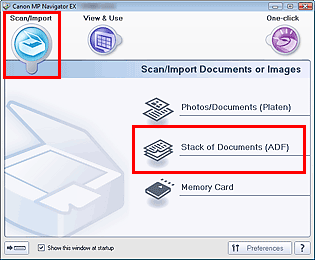
- Select Document Type according to the document to be scanned.
To scan only the front side of each document, select a simplex type such as Color Document(Simplex).
To scan the front side then the back side of each document, select a duplex type such as Color Document(Duplex).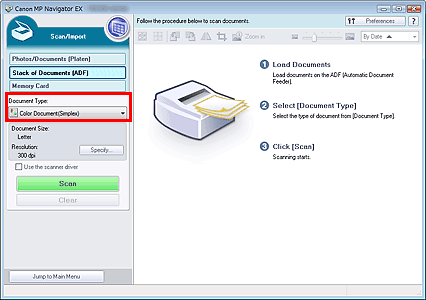
-
Click 'Specify' to set the document size and scanning resolution as required.
- Click 'Orientation' to specify the orientation of the documents to be scanned. In the displayed dialog, you can specify the Original Orientation and Binding Location. How to place the documents when scanning the back sides depends on the Binding Location.
Click here to view the Scan Settings Dialog (Stack of Documents ADF)) - When setting is completed, click 'OK'.

- Click 'Orientation' to specify the orientation of the documents to be scanned. In the displayed dialog, you can specify the Original Orientation and Binding Location. How to place the documents when scanning the back sides depends on the Binding Location.
- Click 'Scan'.
Starts scanning.
Note: Click 'Cancel' to cancel the scan.
When a duplex type is selected for Document Type, the Manual Duplex Scanning dialog opens after scanning. Continue to scan the back sides of the documents.
When a simplex type is selected for Document Type, the Scan Complete dialog box opens after scanning. Skip ahead to Step 9.
-
Follow the on-screen instructions to place the documents.
- When Short Edge is Selected for the Stapling Side in Orientation...
Place the documents without changing the orientation of the output documents.
- When Long Edge is Selected for the Stapling Side in Orientation...
Place the documents after rotating the output documents 180 degrees.
- When Short Edge is Selected for the Stapling Side in Orientation...
- Click 'OK'.
Starts scanning.
Note: Click 'Cancel' to cancel the scan. - When scanning is completed, the Scan Complete opens. Select 'Scan' or 'Exit'.
Select Scan to scan the next document, or select Exit to end.
The scanned images appear in the Thumbnail window.
- Edit the scanned images as required.
Use Edit Tools to rotate images, select a part of an image, etc.
Note: First select images to edit. (Selected images are outlined in orange.) Use shift-click or command-click to select multiple images. You can also select images by dragging and dropping them into the Selected Images area. - Save the scan (as an image or as a document).
Save images scanned with MP Navigator EX to a computer.
- Select the checkboxes of the images you want to save, then click 'Save'.
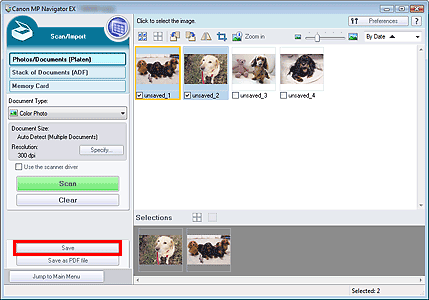
- In the Save dialog, specify the save settings.
Specify the destination folder, file name and file type.Important
Important:
* You cannot select JPEG/Exif when Document Type is Text(OCR), Text(Simplex) or Text(Duplex).
* You cannot select JPEG/Exif when Black and White is selected for Color Mode on the Advanced Mode tab of ScanGear (scanner driver).
Note: By default, the following folders are specified as the destination folders.
Windows 7: MP Navigator EX folder in My Pictures folder
Windows Vista: MP Navigator EX folder in Pictures folder
Windows XP: MP Navigator EX folder in My Pictures folder
Windows 2000: MP Navigator EX folder in My Pictures folder
- Click 'Save'.
Scanned images are saved according to the settings.
To further use/edit the scanned images on MP Navigator EX, click Open saved location in the Save Complete dialog box.
Return to Save
Save images scanned with MP Navigator EX as PDF files.
- Select the checkboxes of the images you want to save, then click Save as PDF file.

-
In the Save as PDF file dialog, specify the save settings.
Specify the file type, file name and destination folder.
Select from the following PDF file types:
- PDF
Save each of the selected images as a separate PDF file. - PDF(Multiple Pages)
Save multiple images in one PDF file.
Note: PDF(Multiple Pages) is displayed when multiple images are selected. - PDF(Add Page)
Add the scanned images to a PDF file. The images are added to the end of the PDF file. You cannot rearrange the pages of the PDF file to which the images are added.
Important:
* Images can only be added to PDF files created with MP Navigator EX. You cannot specify PDF files created with other applications. PDF files edited in other applications cannot be specified as well.
* If a password-protected PDF file is edited, the passwords will be deleted. Reset the passwords.
Note:
* By default, the following folders are specified as the destination folders.
- Windows 7: MP Navigator EX folder in My Pictures folder
- Windows Vista: MP Navigator EX folder in Pictures folder
- Windows XP: MP Navigator EX folder in My Pictures folder
- Windows 2000: MP Navigator EX folder in My Pictures folder
* You can set passwords for PDF files.
- PDF
- Click 'Save'.
Scanned images are saved according to the settings.
To further use/edit the scanned images on MP Navigator EX, click Open saved location in the Save Complete dialog box.
Return to Save
Scan Settings Dialog (Stack of Documents (ADF))
The Scan Settings dialog opens when you click Specify in the Scan/Import window.
In the Scan Settings dialog, you can make advanced scan settings.

- Document Type
Select the type of document to be scanned.
When scanning one side of each document: Color Document(Simplex), Black and White Document(Simplex) or Text(Simplex)
When scanning sides of each document: Color Document(Duplex), Black and White Document(Duplex) or Text(Duplex)
Important: You cannot select Text(Simplex) or Text(Duplex) when the Compress scanned images when transferring checkbox is selected on the General Tab of the Preferences dialog. - Document Size
Select the size of the document to be scanned.
When scanning sides of the documents automatically, select A4 or Letter. - Orientation...
Set the orientation and stapling side of the documents to be scanned.
Click to open the Orientation when scanning from ADF dialog box.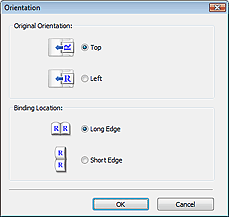
Important: Binding Location cannot be specified when a simplex type such as Color Document(Simplex) is selected for Document Type. - Scanning Resolution
Select the resolution at which to scan documents.
Note: The following scanning resolutions can be specified when Document Type is Text(Simplex) or Text(Duplex).
300 dpi / 400 dpi -
Auto Document Fix
Select this checkbox to sharpen text in a document or magazine for better readability.
Important:
- When this checkbox is selected, the files can be saved in JPEG/Exif or PDF format only.
- Scanning may take longer than usual when this checkbox is selected.
- You cannot select this checkbox when Document Type is Text(Simplex) or Text(Duplex).
- You cannot select this checkbox when the Compress scanned images when transferring checkbox is selected on the General Tab of the Preferences dialog.
- The color tone may change from the source image due to corrections. In that case, deselect the checkbox and scan.
- Descreen
Select this checkbox to reduce moire patterns.
Printed photos and pictures are displayed as a collection of fine dots. "Moire" is a phenomenon where uneven gradation or a stripe pattern appears when such photos or pictures printed with fine dots are scanned. Descreen is the function for reducing this moire effect.
Important: You cannot select this checkbox when Document Type is Text(Simplex) or Text(Duplex).
Note: Scanning takes longer than usual when you enable Descreen. - Unsharp Mask
Select this checkbox to emphasize the outline of the subjects and sharpen the image.
Important: You cannot select this checkbox when Document Type is Text(Simplex) or Text(Duplex). - Reduce Show-through
Select this checkbox to sharpen text in a document or reduce show-through in newspapers.
Important: You cannot select this checkbox when Document Type is Text(Simplex) or Text(Duplex).
Note: Select this checkbox when Document Type is text document and show-through is apparent in the scanned image. -
Correct slanted document
Select this checkbox to detect the scanned text and correct the angle (within -0.1 to -10 degrees or +0.1 to +10 degrees) of the document.
Important:
The inclination of the following types of documents may not be corrected, as the text cannot be detected correctly.
- Documents in which the text lines are inclined more than 10 degrees or the angles vary by line
- Documents containing vertical and horizontal text
- Documents with extremely large or small fonts
- Documents with small amount of text
- Documents containing figures/images or hand-written text
- Documents containing vertical and horizontal lines (tables)
Note: Scanning takes longer than usual when you enable Correct slanted document.
-
Detect the orientation of text documents and rotate images
Select this checkbox to detect the orientation of the document from the scanned text and rotate the scanned image to the correct orientation. Select the language of the document to be scanned in Document Language.
Important:
- This function may not work properly depending on the document language. Only text documents written in languages that can be selected from Document Language are supported.
- The orientation of the following types of documents may not be corrected, as the text cannot be detected correctly. In that case, select the scanned image in the Thumbnail window of the Stack of Documents (ADF) Screen (Scan/Import Window) and rotate it with Edit Tools.
- Resolution is outside the range of 300 dpi to 600 dpi
- Font size is outside the range of 8 points to 48 points
- Documents containing special fonts, effects, italics, or hand-written text
- Documents with patterned backgrounds
Note: Scanning takes longer than usual when you enable Detect the orientation of text documents and rotate images.
- Document Language
Select the language of the document to be scanned. - Defaults
Restores the default settings.
Return to Specify
SIMS Doc Id
0
